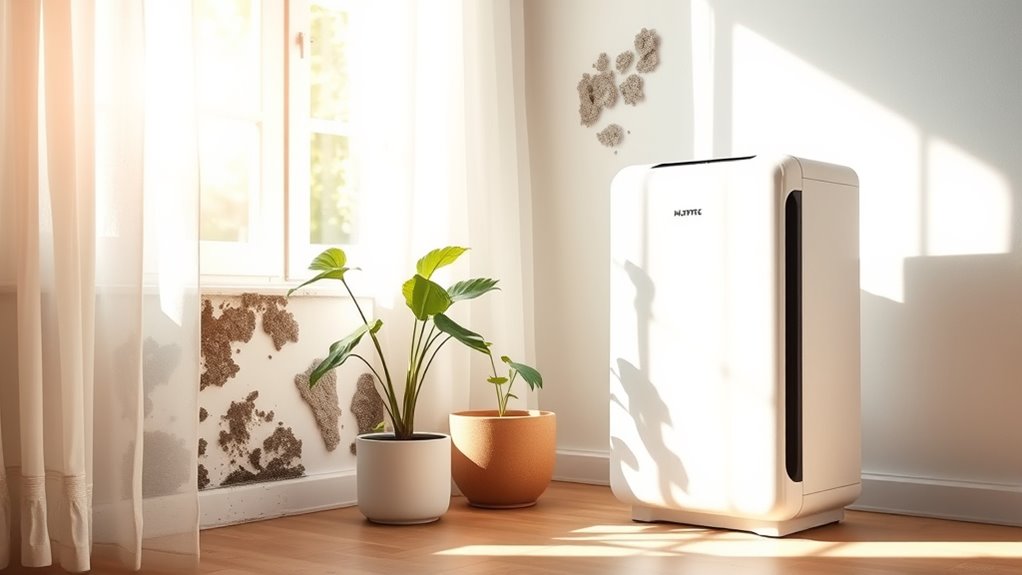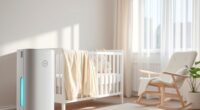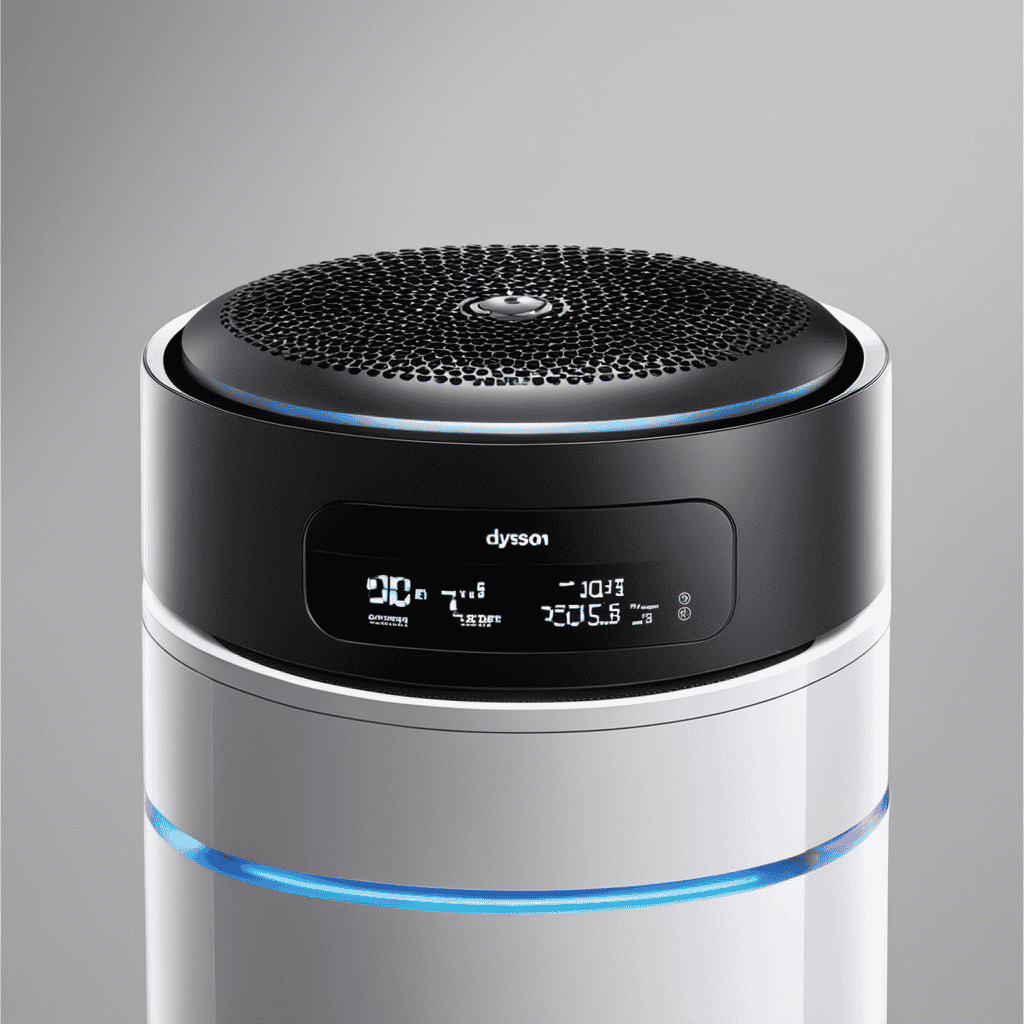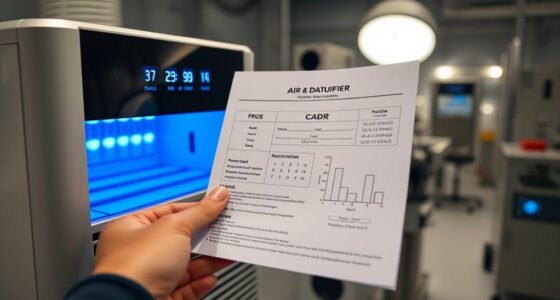An air purifier can help reduce airborne mold spores and odors indoors, but it won’t eliminate mold on surfaces or behind walls. HEPA filters trap tiny spores, while activated carbon absorbs musty smells linked to mold growth. However, purifiers don’t stop mold from growing if moisture and ventilation issues aren’t addressed. To fully control mold, you need proper moisture management and ongoing maintenance. If you want to learn how to get the best results, keep exploring these options.
Key Takeaways
- Air purifiers with HEPA filters can trap mold spores but do not eliminate existing mold on surfaces.
- Activated carbon filters help absorb odors caused by mold and mildew but don’t remove mold itself.
- UV sterilization can destroy mold spores at a cellular level, aiding in air quality improvement.
- Purifiers alone cannot address hidden or surface mold; moisture control and cleaning are essential.
- Effective mold management requires combining air purification with moisture reduction and proper ventilation.
How Mold and Mildew Develop Indoors
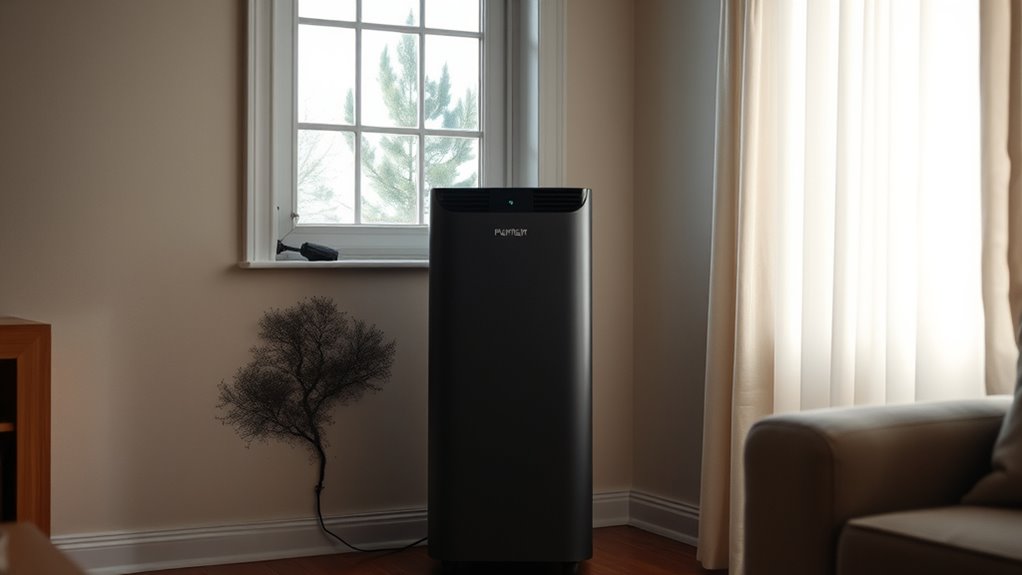
Mold and mildew thrive indoors when moisture levels are high and ventilation is poor. To keep them at bay, you need to focus on mold prevention methods, which include controlling humidity and fixing leaks promptly. Regular air purifier maintenance plays a key role in this process; clean or replace filters as recommended to guarantee peak performance. Poor ventilation traps humid air, creating the perfect environment for mold spores to settle and grow. You can also use exhaust fans in bathrooms and kitchens to reduce moisture. Effective air purification with units featuring HEPA filters can effectively capture airborne mold spores, further reducing indoor mold growth. Additionally, maintaining proper humidity levels below 60% can significantly inhibit mold development. Incorporating advanced air purifier technology can enhance your efforts to prevent mold and mildew indoors. Ensuring proper air circulation helps disperse moisture and prevent accumulation that fosters mold growth. Choosing an air purifier with multi-functionality such as humidity sensors and real-time air quality monitoring can further optimize mold prevention. Consistent upkeep and proactive mold prevention methods are your best defense against these indoor mold issues.
The Capabilities of Air Purifiers in Eliminating Mold Spores
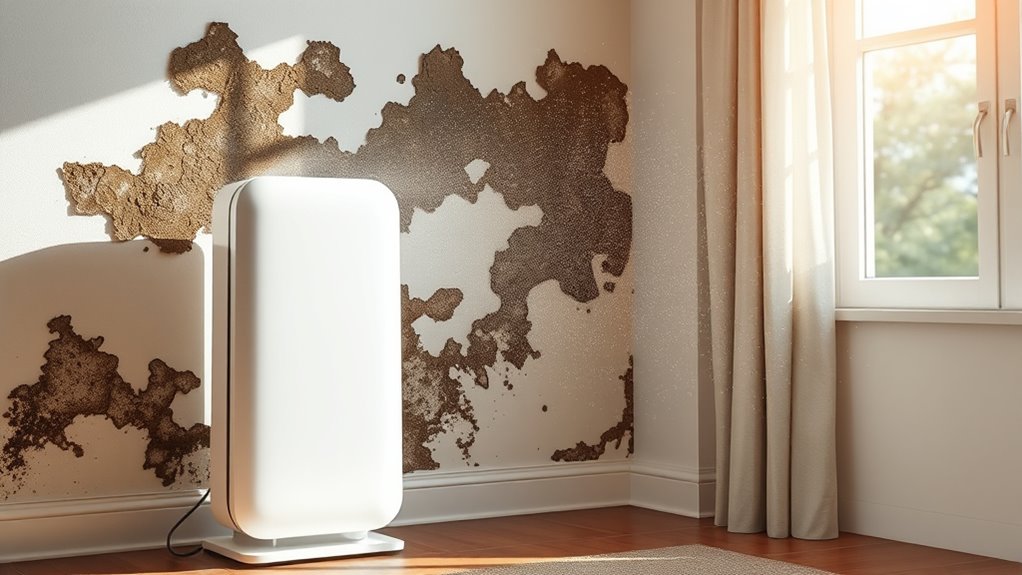
Air purifiers are effective tools in reducing airborne mold spores, especially when equipped with the right features. HEPA filters are key because they can trap particles as small as 0.3 microns, including mold spores. Activated carbon filters complement this by absorbing odors and airborne chemicals associated with mold growth.
To maximize mold spore removal, look for units that offer:
- High-efficiency HEPA filters capable of capturing tiny spores
- Activated carbon filters to neutralize mold odors and VOCs
- Proper airflow rates to circulate indoor air effectively
While air purifiers can considerably reduce mold spores in the air, they work best alongside moisture control and cleaning strategies. This combined approach provides a more all-encompassing solution for mold mitigation indoors.
Types of Filters and Technologies Effective Against Mold

To effectively combat mold indoors, choosing the right filters and technologies is crucial. HEPA filters are highly effective because they can trap tiny mold spores, preventing them from recirculating in the air. Look for air purifiers equipped with HEPA filters to maximize mold removal. Activated carbon filters also play a essential role by absorbing odors and airborne chemicals associated with mold growth, improving indoor air quality. These filters work together to target both mold spores and the musty smells often linked to mold infestations. When selecting an air purifier, confirm it combines HEPA filtration with activated carbon technology for extensive protection. Remember, while these filters considerably reduce mold particles and odors, they don’t eliminate mold from surfaces or prevent future growth entirely.
Limitations of Air Purifiers for Mold Remediation
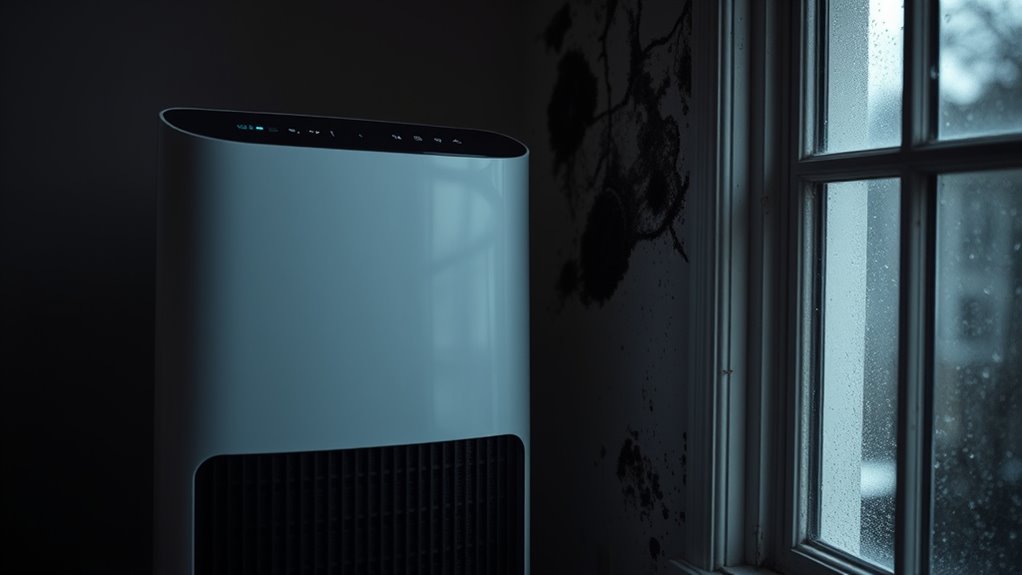
While air purifiers can help reduce airborne mold spores, they have clear limits. They can’t remove mold hidden behind walls or in hidden spaces, and they don’t solve underlying moisture problems. Relying solely on them won’t fully eliminate mold issues in your home. Additionally, choosing the right air filtration technology can improve their effectiveness in capturing mold spores. For optimal results, integrating protective housing and addressing moisture problems is essential. Using models with HEPA filters specifically designed for mold spores can further enhance their ability to filter out these microscopic particles. It’s also important to remember that understanding mold growth conditions is key to preventing future infestations.
Limited Mold Removal Power
Although air purifiers can help improve indoor air quality, they often fall short when it comes to fully removing mold and mildew. Their limited mold removal power means you can’t rely solely on them for thorough cleanup. For effective results, you need to consider:
- Regular air purifier maintenance to ensure peak operation.
- Timely filter replacement to prevent mold spores from recirculating.
- Addressing the source of mold growth directly, as purifiers only trap spores but don’t eliminate the root cause.
- Leveraging advanced technologies and AI discoveries to develop more effective mold remediation solutions.
- Incorporating proper ventilation practices to reduce indoor humidity levels, which can help prevent mold from thriving and spreading. Additionally, understanding retirement planning concepts such as addressing the root cause and proper maintenance can improve long-term mold control strategies.
- Employing moisture control techniques to keep indoor humidity below 60%, which is crucial in preventing mold development. Without these steps, mold spores may linger or re-enter the air even after filtering. While air purifiers can reduce airborne mold particles, their ability to eradicate mold from surfaces or hidden areas remains minimal, emphasizing the importance of other remediation methods.
Ineffective for Hidden Growth
Air purifiers are limited in their ability to detect and eliminate mold hidden behind walls, beneath floors, or within HVAC systems. They cannot reach unseen colonies that grow out of sight, making them ineffective for complete mold removal in these areas. While an air purifier can reduce airborne spores and surface mold, it doesn’t target the source of hidden growth. Unseen colonies can continue to thrive and spread, even when the air purifier is running. This means that relying solely on an air purifier gives you only a partial solution. To fully address mold issues, you need to identify and remove the source of moisture and growth. Otherwise, the mold can persist and cause ongoing health concerns, despite cleaner air. Additionally, understanding the limitations of air purifiers can help set realistic expectations for mold remediation. Recognizing that air purifiers are primarily designed to improve indoor air quality rather than perform comprehensive mold removal is essential for effective remediation strategies. It is also important to consider that mold growth behind walls can re-establish itself if underlying issues are not addressed. Being aware of air purifier capabilities can help you choose appropriate supplementary measures for complete mold control.
Cannot Address Moisture Issues
Even if your air purifier reduces airborne mold spores, it can’t stop new growth caused by persistent moisture problems. Without proper moisture control, mold can continue to thrive despite clean air. To effectively prevent mold, you need to address the root causes of moisture buildup. Here are three key points to consider:
- Fix leaks and water intrusion issues promptly to eliminate sources of excess moisture.
- Use dehumidifiers in damp areas to maintain ideal humidity levels for mold prevention.
- Ensure proper ventilation in bathrooms, kitchens, and basements to reduce humidity and moisture retention.
Air purifiers alone won’t resolve ongoing moisture issues, so integrating moisture control strategies is essential for true mold prevention.
The Role of Proper Ventilation and Humidity Control
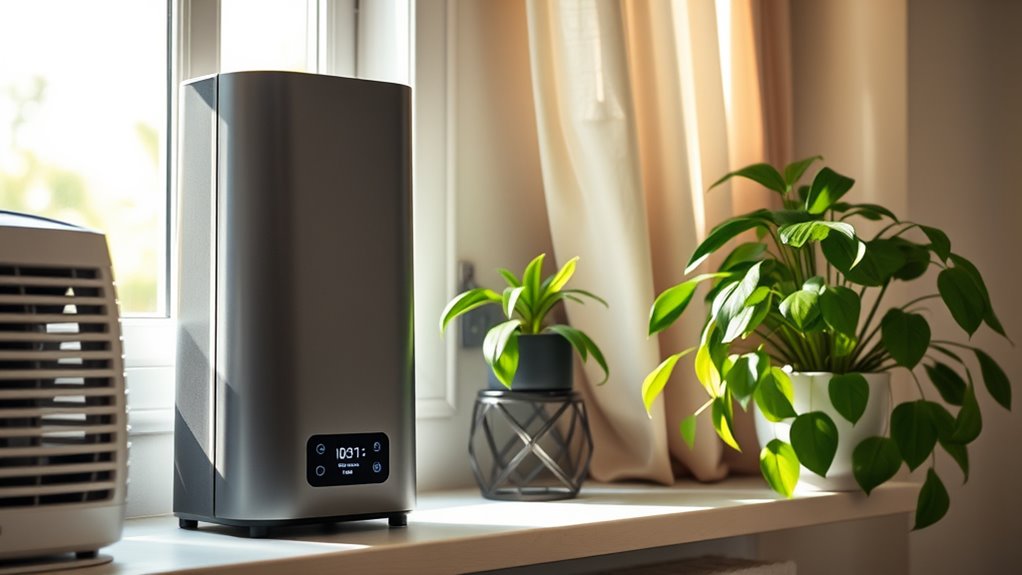
Proper ventilation and humidity control are essential in preventing mold and mildew growth in your home. Good air circulation helps remove excess moisture, reducing the chances for mold to thrive. Maintaining ideal humidity levels—ideally between 30% and 50%—keeps your environment inhospitable to mold spores. To achieve this, use exhaust fans in bathrooms and kitchens, open windows when weather permits, and consider dehumidifiers. Proper airflow and balanced humidity discourage mold development and improve indoor air quality. Here’s a quick visual guide:
| Action | Purpose | Recommended Tools |
|---|---|---|
| Use exhaust fans | Improve air circulation | Bathroom/kitchen fans |
| Open windows | Increase ventilation | N/A |
| Use dehumidifiers | Control humidity levels | Dehumidifier |
| Regularly clean vents | Maintain air flow | Vent cleaning tools |
| Monitor humidity | Ensure levels stay between 30-50% | Hygrometer |
Additionally, proper maintenance of your home’s ventilation system is crucial in supporting these efforts and ensuring ongoing mold prevention. Regularly inspecting and cleaning ventilation systems helps prevent the buildup of mold spores and ensures optimal function. Ensuring that your ventilation system components are in good working order can significantly reduce the likelihood of mold growth. Moreover, choosing appropriate cleaning methods can further reduce mold spores and improve overall indoor air quality. Regularly replacing or upgrading ventilation filters can also enhance air purity and prevent mold proliferation.
Additional Steps for a Mold-Free Environment
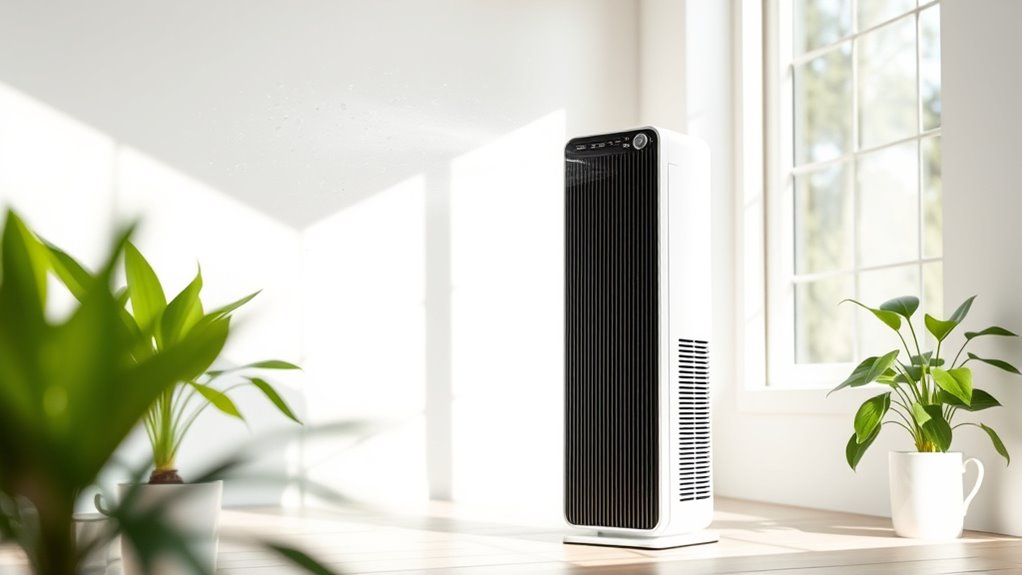
In addition to controlling ventilation and humidity, taking extra measures can further safeguard your home against mold growth. Regular air purifier maintenance ensures it functions effectively, preventing mold spores from circulating. You should also consider mold testing methods to detect hidden mold in walls or behind furniture. Knowing how to properly clean and maintain your air purifier can significantly improve its effectiveness in reducing mold spores. Proper indoor air quality management involves monitoring for potential sources of mold and ensuring good airflow throughout your home. Additionally, understanding mold prevention techniques can help you identify potential problem areas before mold becomes visible. Keeping surfaces clean and dry, especially in bathrooms and basements, is essential, as moisture promotes mold development. Being aware of the regional climate can also influence mold development and guide your preventative actions. These steps help maintain a healthy environment and complement your air purifier efforts. Regularly inspecting and repairing leaks or water damage can prevent mold growth before it starts. These proactive measures are vital for a comprehensive approach to mold control and maintaining indoor air quality. Remember, a proactive approach reduces mold risk and preserves indoor air quality. Regular maintenance and testing are essential for a mold-free home.
Choosing the Right Air Purifier for Mold and Mildew Concerns
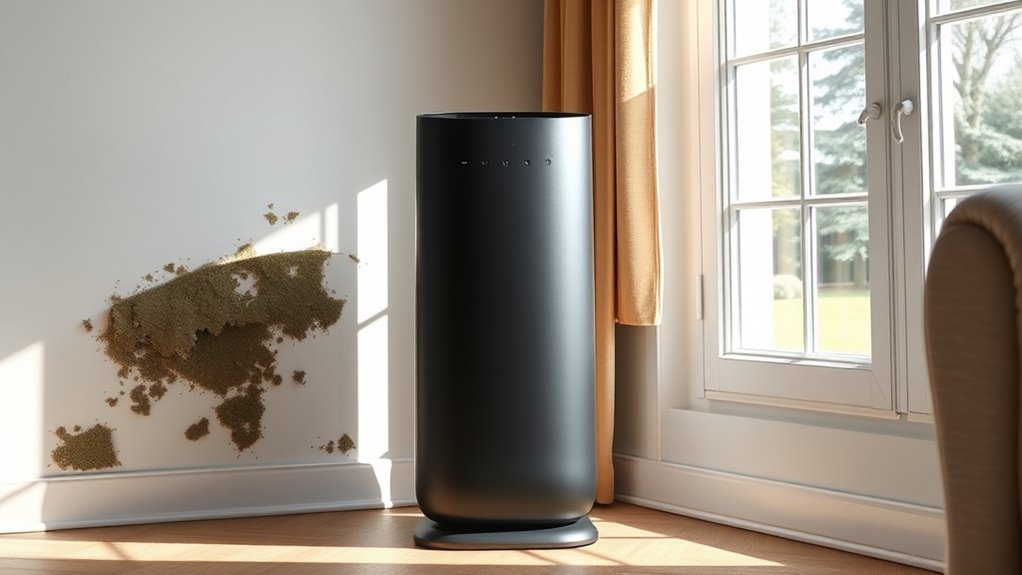
When selecting an air purifier for mold and mildew, you’ll want to focus on effective filtration technologies like HEPA filters that capture spores. You should also consider device features such as adjustable fan speeds and filter indicators for convenience. Additionally, incorporating essential oils such as eucalyptus or tea tree into your cleaning routine can provide antimicrobial benefits that support your efforts to maintain a healthy indoor environment. By choosing the right combination, you can considerably improve your indoor air quality.
Effective Filtration Technologies
Choosing the right air purifier for mold and mildew concerns hinges on understanding its filtration technology. Look for devices that combine multiple methods to guarantee effective removal.
- UV sterilization destroys mold spores and bacteria at a cellular level, preventing their growth and spread.
- Activated carbon filters absorb odors, airborne toxins, and VOCs often associated with mold environments.
- HEPA filters trap small particles like mold spores, ensuring cleaner air.
These technologies work together to target mold and mildew at different stages. UV sterilization reduces viable spores, activated carbon handles odors, and HEPA filters capture particles, providing thorough protection. Choosing a purifier with these features maximizes your chance of creating a healthier indoor environment.
Suitable Device Features
To effectively combat mold and mildew, you need an air purifier equipped with specific features that target these issues. Proper air purifier placement is vital; position it in high-traffic or problem areas like bathrooms or basements for maximum airflow and efficiency. Look for models with adjustable fan speed settings, allowing you to increase airflow during heavy mold spore activity or when air quality drops. A purifier with multiple speed options helps maintain ideal air circulation without unnecessary noise or energy use. Additionally, features like a timer or auto mode can optimize operation based on air quality levels. With the right placement and adjustable fan speeds, your air purifier becomes a more effective tool in reducing mold and mildew indoors.
Frequently Asked Questions
Can Air Purifiers Prevent Future Mold Growth?
You wonder if air purifiers can prevent future mold growth. While they help reduce airborne mold spores, their limitations mean they can’t fully prevent mold from returning. For effective mold prevention, you should also control humidity levels, fix water leaks, and improve ventilation. Relying solely on an air purifier isn’t enough; combining it with solid mold prevention strategies guarantees a healthier, mold-free indoor environment.
Are HEPA Filters Sufficient for Mold Removal?
You might wonder if HEPA filters are enough for mold removal. HEPA effectiveness is high because it captures most mold spores, which are tiny particles floating in the air. However, while HEPA filters improve air quality, they don’t eliminate the mold growing on surfaces. For thorough mold control, combine air purifiers with cleaning and moisture control to prevent mold spores from spreading or returning.
How Often Should Air Purifiers Be Maintained for Mold Control?
Imagine a clean, fresh breeze flowing through your home—this is what proper maintenance gives you. You should follow a regular maintenance schedule, checking filters monthly and replacing them every 6 to 12 months, depending on use and air quality. Regular filter replacement keeps your air purifier working effectively against mold spores and mildew, ensuring your indoor air stays safe and healthy. Don’t wait—consistent upkeep makes all the difference.
Can Air Purifiers Eliminate Mold Odors Completely?
Mold odors can be tricky, but an air purifier helps improve air quality and reduce smells. While it won’t eliminate mold spores or replace proper mold remediation, it can considerably lessen lingering odors caused by mold and mildew. To truly resolve mold issues, make sure you address the root cause through professional mold remediation. Using an air purifier regularly enhances indoor air quality, making your space fresher and healthier.
Do Air Purifiers Harm Mold Spores or Only Filter Them Out?
You might wonder if air purifiers harm mold spores or just filter them out. Generally, air purification devices, especially those with HEPA filters, only trap mold spores instead of destroying them. They do a great job filtering out airborne mold spores, reducing their presence indoors, but they don’t kill or eliminate the spores entirely. To effectively control mold, you’ll also need proper cleaning and moisture control alongside air purification.
Conclusion
While air purifiers can help reduce airborne mold spores, they aren’t a complete solution on their own. To truly prevent mold and mildew indoors, you need proper ventilation, humidity control, and prompt cleaning. Relying solely on an air purifier might leave you wondering—are you doing enough to keep your home truly mold-free? Combining these strategies gives you the best chance to breathe easy and maintain a healthier indoor environment.
